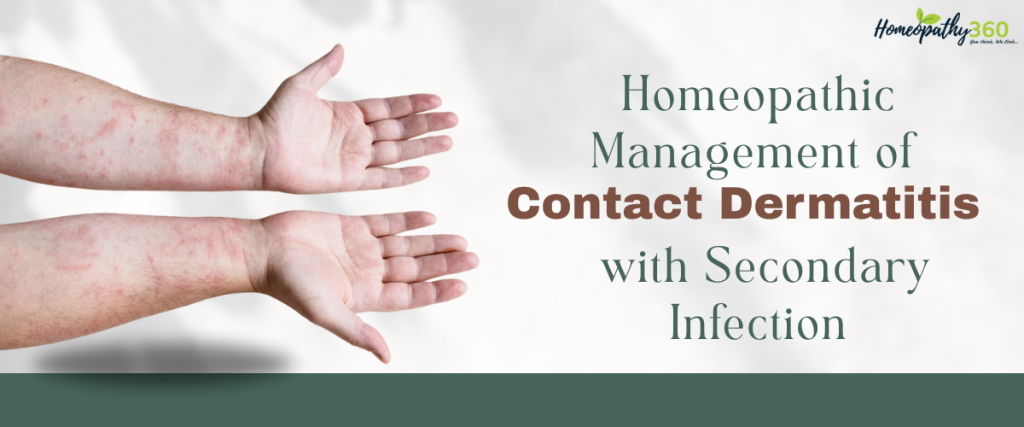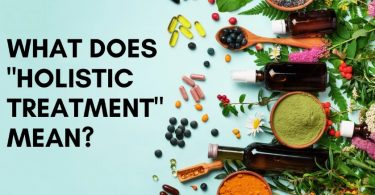
Homeopathic Management of Contact Dermatitis with Secondary Infection: A Case Study
Abstract – Contact dermatitis is an inflammatory skin condition caused by exposure to irritants or allergens. Symptoms included erythema, pruritis, edema, and vesiculation, which may lead to chronic scaling and lichenification with repeated exposure. Homeopathy offers a holistic and individualized approach to managing contact dermatitis with secondary infection by addressing both local symptoms and the patient’s constitutional state. This case – based analysis emphasizes the miasmatic background, mental disposition, and modality- specific symptoms for remedy selection. Hahnemann emphasizes that treating the underlying causes (the internal diseases) through individualized remedies is the only way to achieve lasting cure.
Keywords – Contact dermatitis, homeopathy, individualized treatment.
Introduction –
Eczema is a characteristic inflammatory reaction of skin characterized invariably clinically, by itching, oozing, crusting, and recurrence and histologically, by spongiosis, acanthosis, latensification and perivascular infiltrate. The term “dermatitis” and eczema are used interchangeably. But literally, dermatitis includes all types of inflammations of skin including eczemas1.
Contact Dermatitis –
Contact dermatitis is a common inflammatory skin condition characterized by erythematous and pruritic skin lesions after contact with a foreign substance. It is a cutaneous inflammation on exposure to a substance. Its severity ranges from mild, short-lived condition to severe, persistent and job-threatening state1. The clinical lesions of contact dermatitis may be acute (wet or edematous) or chronic (dry, thickened, and scaly)2
Contact dermatitis is reaction of skin to contactants and is of 2 types:
1. Irritant Contact dermatitis
2. Allergic Contact dermatitis
Irritant Contact Dermatitis (ICD)-
It is a nonimmunological inflammatory response of the body to various kinds of physical, chemical, or biological agents. Its due to direct action of chemicals on the skin and does not require prior sensitization to the concerned agent as required for contact allergic dermatitis. It is seen immediately after exposure and tends to be more painful than itchy.
ICD is generally well demarcated and often localized to areas of thin (eyelids, intertriginous areas) or to areas where the irritant was occluded. Lesions may range from minimal skin erythema to areas or marked edema, vesicles, and ulcers. Chronic low grade irritant dermatitis is the most common type of ICD.2
Approximately 70 to 80% of contact dermatitis cases are ICD. Irritant dermatitis is damage to the cutaneous integrity with epidermal lesions of different degrees of severity and an inflammatory reaction in the underlying dermis.4 Detergents, alkalis, acids, solvents and abrasives are common irritants. Strong irritants have acute effects, whereas weaker irritants commonly cause chronic eczema, especially of the hands, after prolonged exposure. Individual susceptibility varies and the elderly, atopic and fair-skinned are predisposed. Irritant eczema accounts for most occupational cases of eczema and is a significant cause of time off work. Irritant avoidance, including protective clothing (such as gloves), is essential. Emollients and topical glucocorticoids are indicated.5
Allergic Contact – This occurs due to delayed hypersensitivity reaction following contact with antigens or haptens. Previous allergen exposure is required for sensitization and the reaction is specific to the allergen or closely related chemicals. Allergy persists indefinitely and eczema occurs at sites of allergen contact and can secondarily spread beyond this.5
Epidemiology
Dermatitis is a common condition that is reported to affect 5–9% of men and 13–15% of women.6 Data from the National Health Interview Survey (n = 30,074) showed a 12-month prevalence for occupational contact dermatitis of 1,700 per 100,000 workers.7
Pathogenesis – ICD is caused by the direct toxic effect of an irritant on epidermal keratinocytes which results in skin barrier disruption and triggers the innate immune system. An irritant can be directly toxic to epidermal keratinocytes, as is the case with sodium lauryl sulfate, an irritant found in detergents. Acetone (an organic solvent), on the other hand causes disruption of the epithelial barrier by loss of lipids. This disrupts the epithelial barrier allowing increased permeability of irritants and even allergens. Chronic epithelial injury, usually upon repetitive exposure to a weak irritant, triggers the innate immune response with release of several proinflammatory cytokines including IL-1α, IL-1β, TNF-α, GM-CSF, IL-6, and IL-8 from the keratinocytes. In turn, these cytokines activate Langerhan cells, dermal dendritic cells, and endothelial cells. Irritants can also be recognized as Bdanger signals^ by TLRs and Nod-like receptors which activate the inflammasome and NFκB pathways. These cells then release chemokines which results in the recruitment of neutrophils, lymphocytes, macrophages, and mast cells to the epidermis which causes further inflammation. ICD, ACD, and AD often mimic each other, and may co-exist in the same patient. All three disorders are characterized by chronic inflammation.8
Various Clinical Pattern –
Acute Irritant Contact Dermatitis – It results from a single exposure to strong irritant. It is typically seen when patient applies anti-inflammatory cream in excess or concentrated form of Dettol or savlon* on minor cuts or abrasions and presents with erythema, edema and vesiculation.
Sweat Dermatitis- This condition is not described in the literature yet. It refers to asymptomatic and noninflammatory peeling of a brown colored superficial layer of skin in hot and humid weather. Exact etiology is not yet known. It appears to be caused by sweat as an acute ICD. Patients typically complain of peeling of superficial layers of skin without any significant itching. Trunk is the 76most commonly involved site. It is a self-limiting condition. It requires only topical application of emollients.
Chronic Cumulative Irritant Contact Dermatitis- It is typically seen as housewives contact dermatitis due to household irritants, e.g., soaps, detergents, onion, tomato, dung, etc. It presents as dryness, fissuring, hyperkeratosis with variable degree of pain and itching. Occupational exposure to cutting oils or tars can lead to acneiform or pustular eruption on hands and forearms. Patch testing will be negative in these patients. Identification and avoidance of offending irritants are important aspects of management.1
If contact dermatitis is suspected and an offending agent is identified and removed, the eruption will resolve. Usually, treatment with high potency topical glucocorticoids is enough to relieve symptoms. Patient should be questioned carefully regarding occupational exposure and topical medications.2
Homeopathic Point of View
Dr. Hahnemann says, in the introduction to organon of medicine, for without the most minute individualization, homoeopathy is not conceivable, every individual is characterized by some unique features which serve to denote that particular individual from other individuals belonging to the same class or group. In homeopathy we do not stop diagnosis of the disease but go further to diagnosis the patient as well.10
Aphorism no 5 emphasizes the importance of identifying the cause of condition- whether it is external irritant (in contact dermatitis) or internal constitutional factors (as seen in chronic dermatitis or eczema)
Aphorism no 7, in dermatitis cases caused by external factors (like allergens, irritants, or environmental exposure), he said that these maintaining causes must be identified and removed for effective treatment.
In aphorism no 188-203 of organon of medicine, Hahnemann explains that local manifestation like skin condition must be treated by addressing the internal disorder through the use of individualized remedies.
Kent in his lectures mentioned that it is the man who is sick not his organ or tissue, man is prior to the organ the will and the understanding, and the house which he lives in, Man is his body. Each and everything that appears before the eyes is but the representative of its cause, and their is no cause except in the interior. Cause does not flow from the outermost of man to the interior, because man is protected against such a state of affairs. A state of disorder represents its nature to man by signs and symptoms, and these are things to be prescribed upon. Tissue changes
do not indicate the remedy, and so as physicians we must learn to examine symptoms which are prior to morbid anatomy, to go back to the very beginning.11
Case –
A 66-year-old female patient, presenting with itching, burning and crakes on the right hand and fingers. Scanty watery discharge after scratching. Thickened skin with scaly appearance. Bluish discoloration on finger. Gradual onset 1 years, initially mild dryness, which worsened to cracking, burning and oozing. Complaint
Modality – agg. Washing hands, winter, night, detergents, cold air
Amel- cream, avoid detergents
History- Asthma since 12 years
Physical General
Thermal – Chilly
Thirst – 6-7 lit per day
Desire – Sour food
Aversion – Sour food, spicy food
Perspiration – Scanty
Fear – of height, dark, being alone
Dreams – Does not remembered
Stool – Normal
Appetite – Diminished
Sleep – Disturbed because of itching
Mind and Disposition – She is mild and timid in nature. But restlessness and irritability due to discomfort, she became quietly irritable or impatient when physical symptoms persist, especially if the skin infection disrupts daily life. She is generally composed but attentive to small details, especially concerning cleanliness and skin care. She dislikes being left alone. She is emotionally connected with her granddaughter, spending daily time together. She moved to another city for her education. She feels emotionally and physically distanced from her daughter. She feels sad and lonely.
Analysis of Symptoms –
1. Itching, pain, cracked skin on the right hand and finger with scanty watery discharge after scratching.
2. Bluish discoloration of finger. Thickened, scaly skin
3. Aggravated by washing hands, in night, winter, detergents
4. Amelioration: creams, avoiding detergents
5. Chilly patient – sensitive to cold air, and thirsty.
6. Mild and timid nature but becomes quietly irritable and restless due to physical discomfort
7. Fear of being alone, dark, height
8. Fastidious, restless
9. Ailments from grief
10. Desire for company
Rubrics –
Fig 1. – Repertorization
Prescription –
Arsenic album 200/SD
Rubrum 30/BD/15 days
Result –
| Date | Follow-up | Prescription |
| 2/1/25 | Pain and itching in hands improved, no new lesion appears | Arsenic album 200/SD Rubrum 30 /bd/15 days |
| 17/1/25 | Patient feels good, infection in finger is better, swelling in finger reduced | Arsenic album 200/SD Rubrum 30 /bd/15 days |
| 1/2/25 | Patient feels better, itching and pain improved, swelling and bluish discoloration of finger is better | Rubrum 30 /bd/15 days |
Table no.1 – Follow-up
Before –

Fig 2,3,4,5 – Dermatitis
Fig.6,7- After taking homeopathic medicine
Discussion – In this case of Irritant Contact Dermatitis, we have the itching, and dryness of psora, the pustular eruptions as of sycosis and the disorder of squamous cell (ulcers) as of the syphilitic eruption if untreated. Based on the totality of the symptoms, arsenic album is the most suited remedy. It covers the physical, emotional, and miasmatic aspects of the case.
Conclusion – Hahnemann emphasized that skin diseases are not merely local affections but external manifestations of internal, systemic disorder. Irritant Contact Dermatitis is successfully treated with Homoeopathic medicines based on case taking and individualizing the patient. Homoeopathic treatment has shown the ability to improve Irritant Contact Dermatitis internally and helped to remove the predisposition state of the Irritant Contact Dermatitis.
References –
1. Bansal R. Essentials in Dermatology, Venereology & Leprology. 1st ed. New Delhi: Jaypee Brothers Medical Publishers; 2015.
2. Kasper DL, Fauci AS, Hauser SL, Longo DL, Jameson JL, Loscalzo J, editors. Harrison’s principles of internal medicine. 19th ed. New York: McGraw-Hill Education; 2015. 3. Khanna N. Illustrated synopsis of dermatology & sexually transmitted diseases. 7th ed. New Delhi: Elsevier; 2023.
4. Slodownik D, Lee A, Nixon R. Irritant contact dermatitis: a review. Australas J Dermatol 2008; 49: 1-9.
5. Ralston SH, Penman ID, Strachan MWJ, Hobson R, editors. Davidson’s Principles and Practice of Medicine. 23rd ed. London: Elsevier Health Sciences; 2018.
6. Meding B, Swanbeck G. Prevalence of hand eczema in an industrial city. Br J Dermatol 1987;116:627–34
7. Behrens V, Seligman P, Cameron L, Mathias CG, Fine L. The prevalence of back pain, hand discomfort, and dermatitis in the US working population. Am J Public Health. 1994;84(11):1780-1785.
8. Bains SN, Nash P, Fonacier L. Irritant contact dermatitis. Clinical reviews in allergy & immunology. 2019 Feb 15;56(1):99-109.
9. Pramanik A., Acne Vulgaris And Its Homoeopathic Management: A Review. TUJ. Homo & Medi. Sci. 2022;5(3):10-18.
10. Sarkar BK. Hahnemann’s Organon of Medicine. 6th ed. Kolkata: Roy Publishing House; 2007.
11. Kent JT. Lecture on Homoeopathic Philosophy. re print Ed. New Delhi: B. Jain Publishers Pvt Ltd. 2002
Dr. Shivangi parihar
(MD Scholar)
Guide – Dr. Rakesh sonkusare
Department – organon of medicine
Government homeopathy medical college and hospital,
Bhopal (M.P.)





